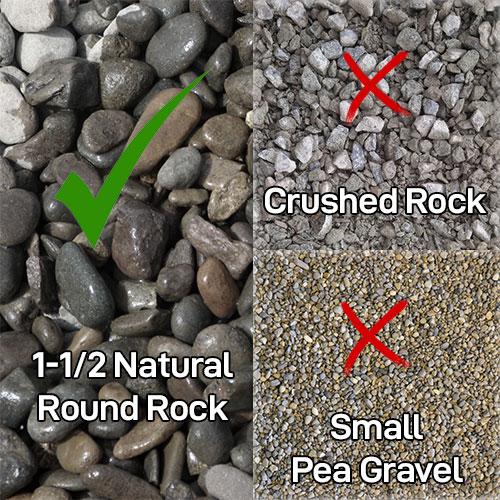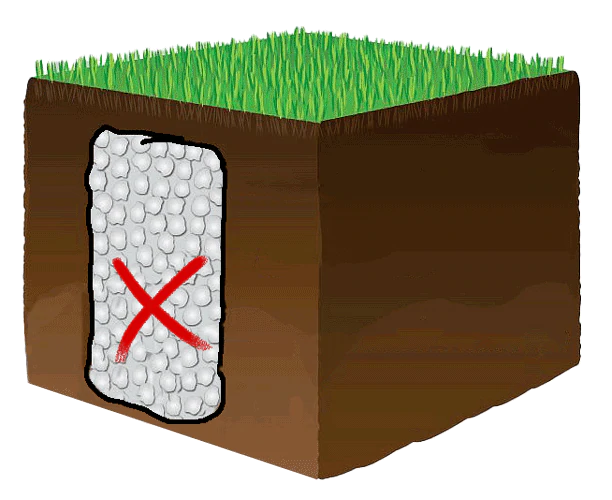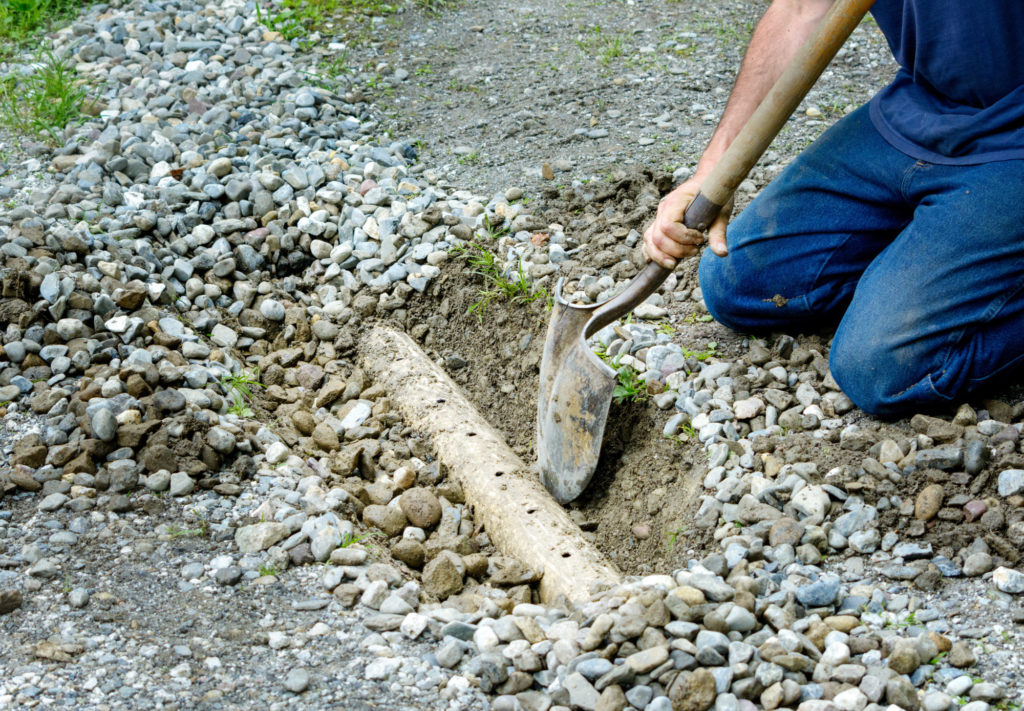If you’re like most people, you’ll make mistakes while trying to drain your french Drain. But don’t worry – there are plenty of ways to fix them!
In this article, we’ll list the most common french drain mistakes and provide tips on avoiding them. We hope that this will help you get the drainage job done right the first time!
Recommended:
Table of Contents
French Drain Mistakes
There are a few common mistakes that people make when using French Drain. Let’s take a look at some of the most common ones and how to avoid them.
- Utilizing the wrong kind of drainage rock
- Not lining the trench & pipe with drain fabric
- Placing the excavated soil back into the trench
- Lack of positive slope for the drainage system may cause problems
- Slope Part
- Gravel-Only drain installation without a Drain-pipe
Utilizing the Wrong Kind of Drainage Rock

Use clean natural round stones as your drain fill material for proper installation and drainage of a French drain system. This will allow good water flow through the aggregate and to the piping, preventing clogs and ensuring an efficient drainage system.
The recommended choice for a stone is ‘1’ clean rock. This type of stone has few blemishes and will not require any special care when installed into your project.
This type of rock will have the best drainage results, allowing excess water to flow away quickly and keeping your plants dry.
Don’t Use Small Pebbles
Avoid any smaller pea gravel as the spaces between stones are smaller and will create a minimizing flow rate. If you encounter a rock with such fines, try to chip them away before placing the rock in the piping system.
Key findings
- French drains are an excellent way to improve drainage in your garden or patio area.
- Proper drainage rock is essential for a successful French drain installation.
- Choosing the right type of stone can help ensure good water flow through the system.
- Clean, natural stones provide the best possible results for your Drainage project.
- Taking all necessary precautions during construction will result in a successful Drainage system.
Not Lining The Trench & Pipe With Drain Fabric
Dirt & Debris Mix With Rockfill
If your French drain system does not have a drainage fabric lining, the dirt and debris will mix with the rock fill, leading to early failure of your drainage system. By lining your French drain trench with a non-woven geotextile drainage fabric, you’ll ensure proper soil separation and prevent damage to your foundation from water infiltration.
Use Polythene Tap For PVC
If you are using a PVC pipe trench, you should line it with polythene tape. If your trench is made from natural soil or concrete, use the Wrap installation method to ensure proper drainage and long-term system performance.
If you’re looking for a long-lasting drainage fabric, high-quality options are worth considering. These fabrics can last for decades without issue, so they’re great choices if your home has existing drainage problems.
Key findings
- French drain installation requires a trench lined with a non-woven geotextile drainage fabric to prevent water infiltration and avoid damage to your foundation from water intrusion.
- If your French Drain does not have a drainage fabric lining, the dirt and debris will mix with the rockfill, leading to early failure of your drainage system.
- Proper soil separation is critical for the proper functioning of a French drain.
- If you are sealing a trench or creating an outdoor drainage system, use a sock-wrapped perforated pipe and drainage fabric. Using the sock wrap alone can easily clog with dirt/soil, which will decrease the efficiency of your drainage system.
Placing the excavated soil back into the trench
Suppose you have created a new trench for your drainage system, and the soil/clay mixture is piling up on top of it. In that case, it is best to avoid adding the additional soil back into the trench unless you are putting a sod strip on the drain. Instead, use a thin layer of dirt to cover the newly created drainage hole.
Key findings
- To avoid adding soil back into the trench, only add a thin layer of dirt if you are installing sod on top of the drain system
- Trenching can be a chore and can be challenging when working in tight spaces or under difficult conditions; always use caution!
- Always wear appropriate safety gear (eg: gloves, eye protection) and avoid getting wet while trenching to prevent muddy water from settling
Lack of positive slope for the drainage system may cause problems
Pooling water can cause major issues for your drainage system and create problems. It is important to take the time to make sure that your drain pipe is at an angle so that gravity will help drain the water out. This will help keep drainage systems running smoothly and avoid any problems with too much water retention.
Key findings
- Pooling water in a drain pipe can create serious problems for your French drainage system.
- It’s important to angle the pipe so that gravity will help drain the water out.
- Affordable drainage of North Houston always considers how water will flow and designs accordingly to avoid any issues or complications down the line.
- Proper installation is key when trying to avoid any potential drainage woes.
Let’s discuss about Slope

No slope – A slope will affect the amount of water that flows through a drain. A flat pipe will require more energy to move water through it than a pipe with a slope, which can result in poor drainage.
Low Spots – Be mindful of low spots in your French drain trench and avoid pooling which can increase the retained water within the drainage line. If tree roots are attracted to this standing water, it will block flow and reduce the effectiveness of your French Drain system. Our experienced contractors always take into account surrounding trees when installing a French Drain project so that you never have to worry about drainage again!
To properly prevent tree roots from penetrating your French drain, building one with low spots and retaining water is important. This will help keep the system damp and discourage plant growth through the fabric. If your drainage system does happen to have areas that allow root penetration, be sure to keep them moistened so as not to encourage further tree growth.
Negative Slope – If a property or pipe has a negative grade, water must be forced to flow through the system using pumps. This can be costly and energy-intensive, which is why it is generally considered undesirable.
A drainage pipe with a negative slope can cause water to back up and around a structure, so it’s important to have a pump system if you want your drain to flow away from the area.
Ideal Slope – If you have a trench with a greater than 1.5% grade slope, gravity will take care of distributing the water throughout your drainage system that’s why this grade is ideal for your trench.
Gravel-Only drain installation without a Drain-pipe

If you’re installing drainage and you miss the pipe, your system won’t be able to handle heavy water flow. This can lead to reduced drainage effectiveness and an increased chance of flooding in your home. Make sure to correctly install the drain pipe if you want your system to work properly.
A drainpipe is necessary for drainage in order to prevent water from pooling around buildings. It should be surrounded by round drain rock and the proper fabric to provide the capacity to move this water away from structures.
Key findings
- The purpose of a fabric drainage hose is so that water can flow away without harming any structures or property
- Missed pipes can cause reduced drainage effectiveness and an increased chance of flooding in your home
- Proper installation will help ensure a successful drainage system

